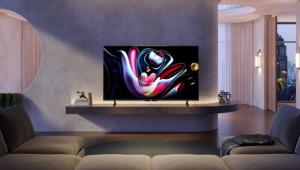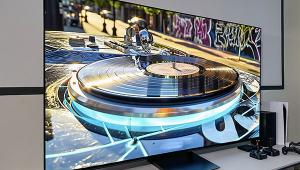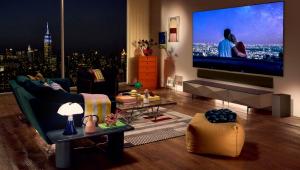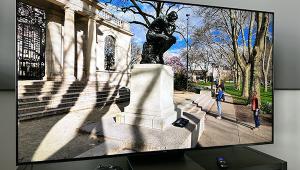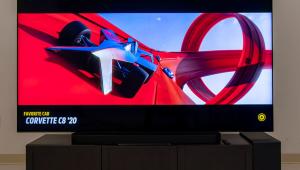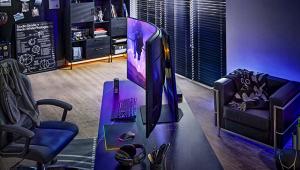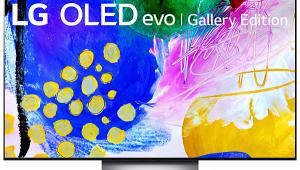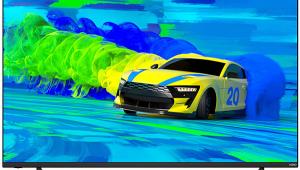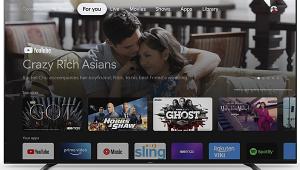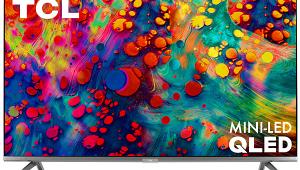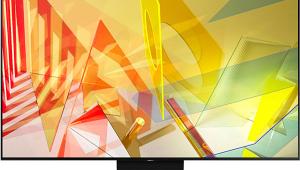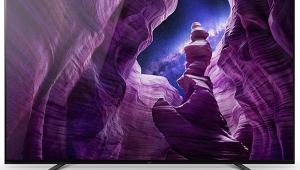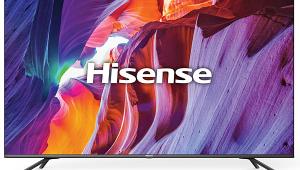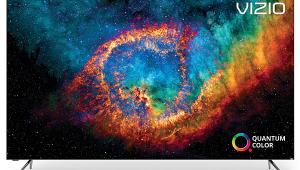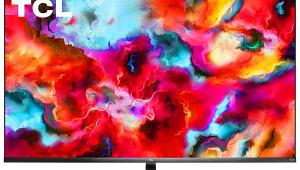On Thanksgiving day you can purchase a 75"Samsung Q80r for $2,200, or a Vizio 75P Quantum X for $2,000. These two models are direct competitors to the TCL 8 series. For $3,500 The Samsung 82"Q80r is a far better dollar value compared to $3,000 for TCL 75Q825.
Now if, TCL drops the price down to $2,000 during this weekend Holiday sale, then still buy the Samsung (Panel lottery odds are way better with the Samsung than a TCL).
TCL 75Q825 8-Series Roku LCD Ultra HDTV Review Page 2
The TCL's motion smoothing controls include Action Smoothing (de-blur, for programs shot at 30 and 60 frames per second) and Action Clarity (de-judder for 24fps film-based content). Action Clarity makes filmed material look like video—the Soap Opera Effect that's common to all set's I've tested offering such a feature. A separate LED Motion Clarity control adds black frame insertion, which can improve motion resolution though it also darkens the picture. For my evaluation, I left all motion smoothing switched off.
With the one TV Brightness control exception noted above, I used the default settings of the TCL's Dark (HDR) picture mode. Viewing angle was typical of most sets that use VA (Vertical Alignment) LCD panels, with both contrast and color starting to fade at much beyond a 20 degrees off-center seat. Some of TCL's prime competitors, particularly Samsung's Q80R and Q90R, have recently made major advances on this front. But when viewing with the 8-Series, you'll definitely want to grab a center seat.
A very brief (no more than two seconds) full black image appears onscreen in the opening frames of Harry Potter and the Deathly Hallows Part 2. With the TCL's Brightness set to 50 (the default), the set flashed rapidly between black and dark gray during this brief "interstitial." When I set the Brightness to 51, the blacks stabilized but also looked slightly less rich. This might indicate an issue with the set's handling of transitions from the darkest gray to full black—a difficult parameter to get right in the design of a digital display. Also, some of the darkest details on the Spears & Munsil disc's contrast patterns looked red rather than a dark gray. Both of these are issues that might be fixable via a firmware update.
 Such black level quirks never affected any other source material I watched; for the most part The TCL's image looked consistently superb. With the Dark (HDR) picture mode's default settings active, color, from deep reds to natural greens, was hard to criticize. Nor did I have any complaints about the set's detail. Images were satisfyingly uniform, and I never spotted any false contouring, or "banding," artifacts.
Such black level quirks never affected any other source material I watched; for the most part The TCL's image looked consistently superb. With the Dark (HDR) picture mode's default settings active, color, from deep reds to natural greens, was hard to criticize. Nor did I have any complaints about the set's detail. Images were satisfyingly uniform, and I never spotted any false contouring, or "banding," artifacts.
I spent much of my time viewing three Ultra HD Blu-rays I'm intimately familiar with. Fortunately, a 75-inch Samsung Q80R model was set up side-by-side with the TCL to enable direct comparisons that I've folded into the comments below. I slightly altered the Samsung's Backlighting and Brightness controls to more closely match the post-calibration adjustments I had used in my review of the company's 65Q80R, which in its factory default settings also deviates from the luminance standards of the PQ curve to enhance HDR punch.
Some scenes from the sci-fi action film Oblivion looked slightly better than others on the TCL, but in general images looked as good as I've seen them on the best sets, with a bit more punch in highlights such as the lightning strikes when Jack fights to control his bubble-copter. I had no reservations about color here, and the few dark scenes I sampled were well-handled. HDR highlights on the TCL looked marginally punchier than on the Samsung, and it had slightly better detail. But the latter occasionally came across a bit too aggressively, with some closeups of faces looking more natural and a little less processed on the Samsung. Short of viewing the master file in the studio where the transfer was made, likely with a five-figure mastering display close by, it's hard to say for sure which image was more accurate, although some of the chroma resolution blocks on the Spears & Munsil test disc did indicate slightly lower chroma resolution on the Samsung.
Guardians of the Galaxy Vol.2 was largely a tossup. Yes, some scenes on the TCL again looked a bit more processed compared with the Samsung, but "a bit" is reviewer shorthand for "it was so subtle I had to concentrate hard to find anything to complain about." Both sets excelled in all facets of their performance, though again the TCL delivered brighter HDR highlights. The difference was hardly jaw-dropping, however, since Samsung's Q80R series sets are no slouch when it comes to peak brightness capability.
Harry Potter and the Deathly Hallows Part 2 is a black level and shadow detail mine field for a video display to navigate. Apart from the exception mentioned above, the TCL handled this disc extremely well, though I can't confidently claim it was better here than the Samsung since I only noted subtle differences on some scenes. That might appear odd considering the difference in the number of local dimming zones between the two sets (I had measured about 100 in my review of the 65-inch Samsung Q80R, and would expect the 75-incher to have somewhat more). But the processing used to control local-dimming zones also has an impact on their effectiveness. In the iconic shot that begins chapter 12 where Voldemort and his minions stand on a bluff overlooking Hogwarts, both sets excelled, though the heads of the group stood out more prominently against their dark robes on the Samsung. Which was correct? Again, I wasn't in the room when the film was graded and finalized, but I can say for certain that the TCL performed superbly on this extremely difficult material.
 A starfield is perhaps the toughest TV black level and contrast test of all. The Spears & Munsil test disc includes one, and while The TCL handled it well, its performance here wasn't clearly better than the Samsung. There was no OLED in the room for comparison, but I can say with certainty that neither set came close to what an OLED can do with a starfield.
A starfield is perhaps the toughest TV black level and contrast test of all. The Spears & Munsil test disc includes one, and while The TCL handled it well, its performance here wasn't clearly better than the Samsung. There was no OLED in the room for comparison, but I can say with certainty that neither set came close to what an OLED can do with a starfield.
I'll repeat that all of my tests were performed in a fully dark room. Even modest room lighting will obliterate many differences between TVs and that includes the "halos" that appear around bright objects on a black background with local dimming LCD models. I had no serious complaints against the TCL on that front, though as with all LCD TV's I've tested, there was some degree of visible halos.
HD/Standard Dynamic Range Performance
I spent all of my very limited HD/SDR time with the TCL viewing HD/SDR test patterns from the Spears & Munsil HD Benchmark disc (the release that preceded the Ultra HD version), plus various other test Blu-rays containing excellent demo material. None of this revealed any significant issues with the TCL's upconversion of HD to 4K. On the contrary, all of it demonstrated the 75-inch 8-Series set's superb overall performance.
The one HD Blu-ray movie disc I had time to sample was My Fair Lady. Color and detail on the TCL were uniformly exceptional, apart from a shot or two that might well reflect the fact that no restoration of a 55-year-old movie will be perfect. On the TCL, the disc looked as good as I've ever seen it.
Conclusion
With TCL selling the 75-inch 8-Series model evaluated here at $3,000, and a 65-inch model for $2,000, more pricey high-end LCD TV brands now have some serious competition. While it's understandable that discerning viewers shopping for a new set may opt to fall back on the reputation of a more established brand, they'd be well advised to give TCL's 8-Series a very close look.
- Log in or register to post comments


It's exciting to see more options in the high-end HDTV space! But how much does a concrete patio cost?

https://www.charlottedrywallpros.com is impressed on how TCL, known for budget sets, is making a bold move into the high-end Ultra HDTV market.

This article really helped me decide which Roku model to choose for my office over at https://centuryelectricalservices.com/

I came across this detailed TV review, and while high-end features like HDR performance are impressive, I’m more intrigued by other online finds. For instance, 22bethu-app offers a completely different kind of entertainment experience that’s both exciting and accessible. It’s perfect for anyone looking to unwind and have fun, all while enjoying the comfort of home.

